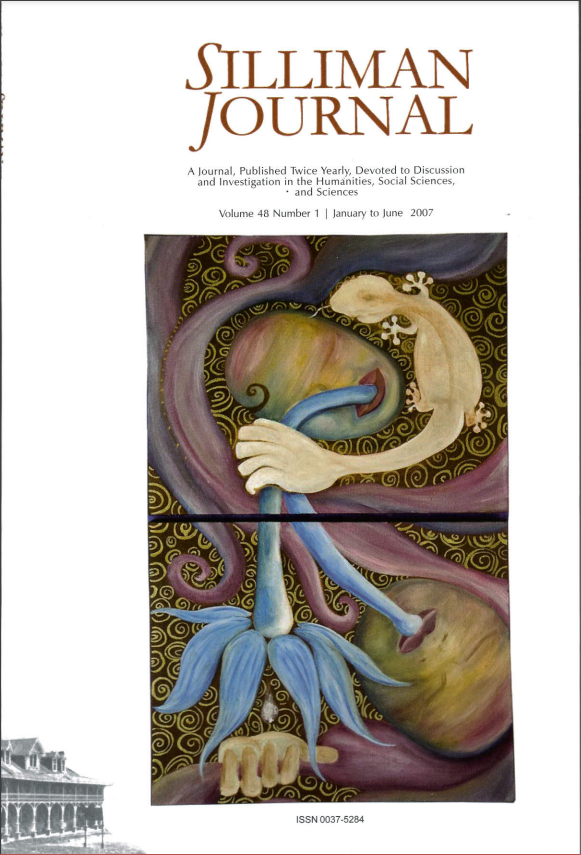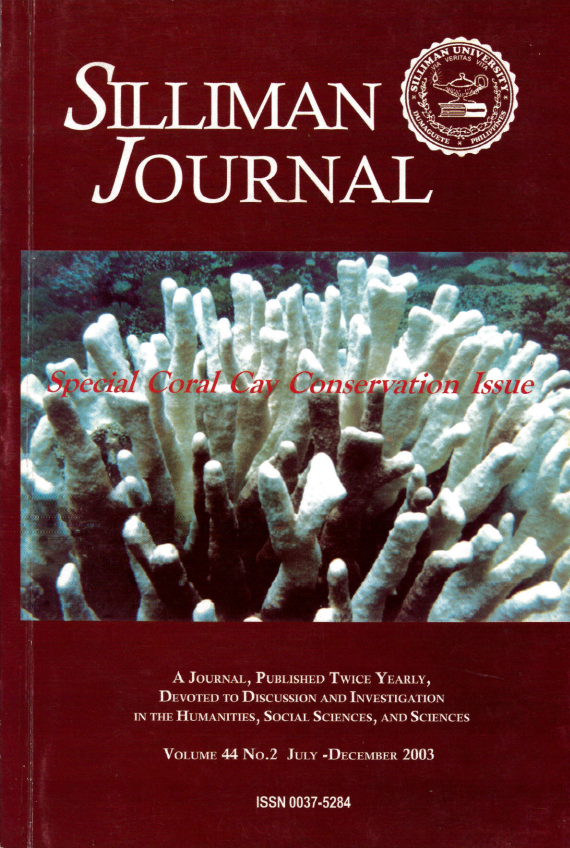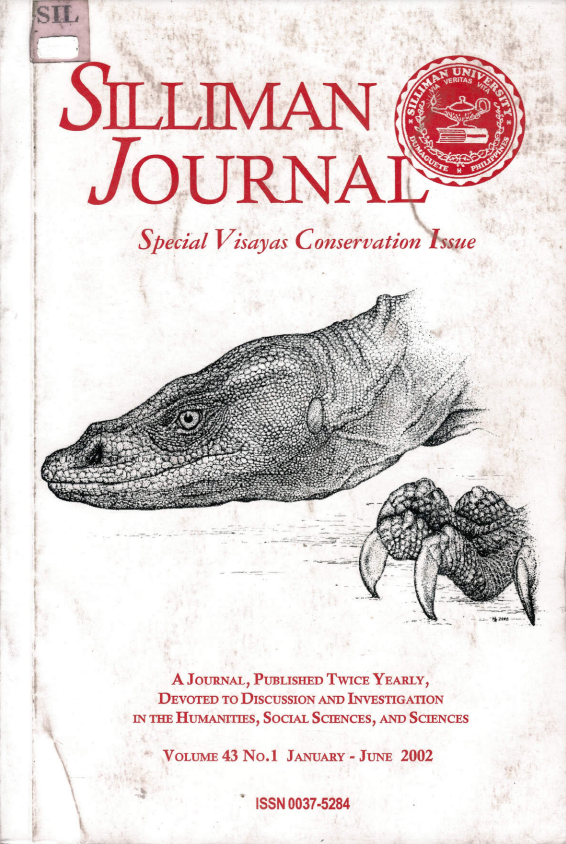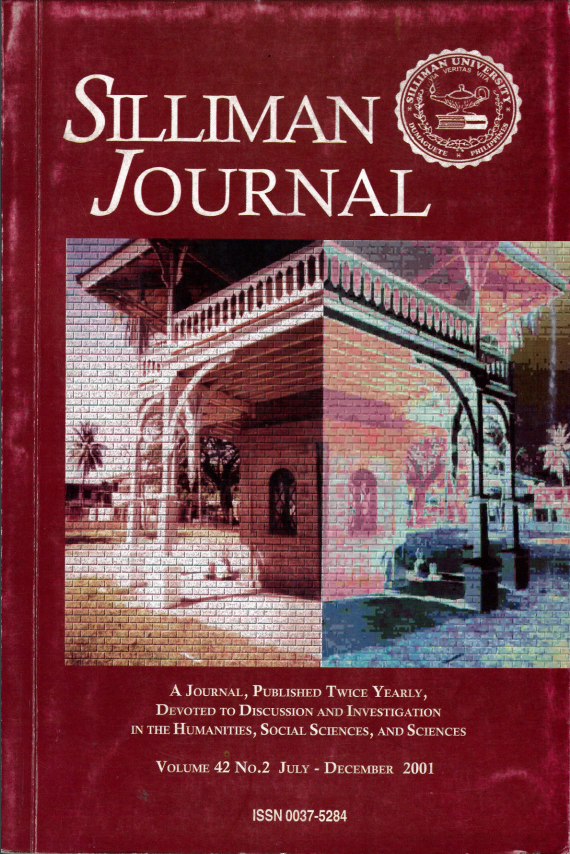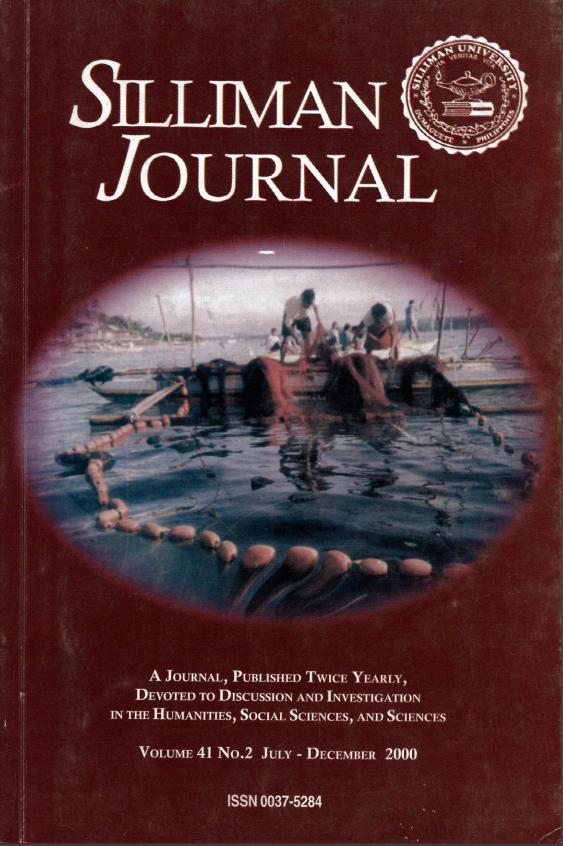Archives - Page 3
-

Silliman Journal
Vol. 49 No. 2 (2008)Welcome to this issue of Silliman Journal. Without conscious intention, this issue has turned out to be a collection of ideas that address unique social concerns, from biological, sociological, and psychological perspectives. This second issue of SJ 2008 begins with biologists Ma. Rio A. Naguit, Hilconida Calumpong, Janet Estacion, and Wilson Tisera collaborating in a study on “The Siphonal Mantle Morphology of Tridacna crocea.” According to the authors, Tridacna crocea is the smallest among the eight species of Family Tridacnidae and the most abundant tridacnids in reefs around the Philippine archipelago. The study identified 13 mantle patterns in the tridacnids of six reef areas: Pamilacan, Tañon Strait, Carbin, Camiguin, Southeastern Samar, and Spratlys; and analysed mantle morphs and genetic structure. A somewhat related paper is an analysis of “Marine Protected Area-Based Tourism” by Silliman research director Dr. Enrique G. Oracion. Dauin, Negros Oriental has been the location of much of Oracion’s research work while coastal resource management has been an important personal research interest. In this particular study, he highlights the role of marine protected area-based tourism—that is, recreational diving and snorkeling—as a variant of coastal ecotourism that operates in a critical equation that is both very fragile and controversial. This type of tourism, he said, is particularly vulnerable “if not regulated or tempered by the actors of the tourism system composed of brokers, locals and tourists.” Then, biology professor Brigitt Villordon’s thesis entitled “Prevalence and Risk Factors of Enterobiasis Among Pre-School Children in Selected Barangays in Dumaguete City,” brings about concern over our children’s health and well-being. As knowledge, attitudes, and practice (KAP) scores increase, prevalence decreases, and Villordon recommends continuing health education programs. Just as important to residents’ welfare, “A Profile of Street Noise in Dumaguete City Streets” by Physics professor Dr. Hope Bandal, considered data on sound pressure level, traffic density, and construction layout such as width of the street, make and construction type of buildings, and the presence of trees and open spaces beside the streets. The results indicate that there is a high correlation and thus, a marked relationship, between sound pressure level and traffic density, and Bandal points to the worthiness of considering how noise pollution may be minimized in urban planning. In the final paper among our full-length articles, Michele Valbuena, associate professor in women’s studies, asks “Who is Happy? Who is Not Happy?” in her study of technology mediated communication among Filipina domestic workers in Hong Kong. In addressing life satisfaction among overseas workers, Valbuena contributes to family and women’s issues research as well as to a greater understanding of the diaspora experience. We have an interesting mix of essays in this issue’s Notes Section, beginning with biologist Abner Bucol’s observations of folk medicine for toothache relief using toob in Siquijor Island, Philippines. This is followed by “Asian Christologies: Images and Metaphor” by theologian and women’s studies educator Lilith Usog. The section is rounded off by Prof. Betsy Joy Tan’s essay on “Teaching as Service for Knowledge Work.” Finally, this SJ includes a book review by writer-poet Bobby FloresVillasis of The Folk Healers: Sorcerers of Siquijor, Isla del Fuego, published in 2004 by Silliman professors Rolly and Evelyn Mascuñana. Isla del Fuego (Island of Fire) is the old name of Siquijor Island and the anthropologists Mascuñana tell of the island’s yearly pangalap (search for materials that are used as ingredients in concoctions for their traditional practices). Villasis’ review is both personal and informed and it is a joy to read. I would like to thank all contributors to this issue—authors, reviewers, SJ Editorial Board (including our colleagues overseas) and SJ editorial staff. Special thanks go to history and fine arts professor, Jutsze Pamate, whose artwork graces our cover. As told by another local artist Muffet Villegas, Jutsze is versatile in using different media, his latest passion being the use of ancient coffee beans to bring back the past in his captivating landscapes. Of Jutsze’s work, Villegas says: “The coffee stains become the time machine which does not only promote the ancient feeling of the theme, but it becomes the color that spells magical memories to the young and the old.” I join the rest of the Silliman community in inviting contributions to Silliman Journal, for “one’s life is a quest,” so states Jill Ker Conway, editor of a collection of autobiographies Written by Herself (1992), “…to realize one’s vision of beauty, to see more deeply into nature, to escape from Egypt into the Promised Land.”
-

Silliman Journal
Vol. 38 No. 3 and 4 (1997)IN THIS ISSUE: The focus on the issue of environment and development provides the thematic framework for this edition of SILLIMAN JOURNAL. It has been noticeable in recent years that the focus on the environment as a study has attracted the attention of several scholars representing many of the shades of opinion that are characteristic of this disparate discipline. Seven articles in this issue contributed by authors coming from different disciplinary backgrounds address both the human and the natural aspects of the environment from a variety of perspectives. The first six articles in particular explore what in Environmentalism has come to be known as “ecosocietal restoration” which calls for a reexamination of human society’s relationships with natural systems so that the destruction and repair of ecosystems can be sustainably balanced. A common thread running through these articles is the emphasis on the importance of understanding connections both within natural systems and with social and economic concerns. All six articles implicitly argue for alternative policy initiatives which take into account environmental literacy and the need to educate the public in order to change attitudes and behaviors that are deleterious to natural systems.
The first three articles explore this theme within the context of the lives of the indigenous peoples of Negros Oriental. These three articles were outgrowths of the Ancestral Domain Research Project commissioned by the Provincial Environment and Natural Resources Office of Negros Oriental. The leading article by Nichol R. Elman and Ceres E. Pioquinto discusses the specific research methodology designed for the special requirements of the Ancestral Domain Research Project. In the second, Rolando V. Mascufiana reports the findings of his ethnographic study on the Negritos of Canggohob, Mabinay and
the Bukidnons of Tayawan, Bayawan and Cabatuanan, Basay, Negros Oriental. The third article by Andrea G. Soluta with Wilfa Glynnis V. Manginsay offers baseline information on the present situation of the indigenous cultural communities of Negros Oriental, and concludes with a situational analysis by
Ceres E. Pioquinto.The next two articles by Betty C. Abregana and Enrique G. Oracion respectively were products of the Palawan Formative Research in Support of Environmental Communication Campaign. These two articles provide a comparative analysis of the knowledge and practices of local government officials, opinion leaders, and local residents relative to the environment. These two studies raise the question of how national and local government policy aims may be linked to resource management while at the same time suggest the vital role of environmental communication campaign as the key to changing the public's
attitudes and behaviors that are detrimental to the environment.In a similar way, Angel C. Alcala’s article suggests the connection between policy initiatives and local habitat and livelihood, linking sound environmental practices to community rehabilitation programs. In particular, it considers the role of organized communities and the Community Based Fishery Management approach as one of the effective strategies in solving the problem of dwindling fishery resources and argues for the establishment of marine reserves in the management of coastal fisheries.
Although departing from the general theme of this issue, but still necessarily part of the natural landscape, the subject of this issue's final article by Wayne A. Brown will be of particular importance to entomologists and to anyone interested in the distinctive and dynamic interactions among air, water, soil, biota, and people which constitute the environment.
-

Silliman Journal
Vol. 38 No. 1&2 (1997)"Expressing Nursing as Caring through Music", this issue's lead article by Rozzano C. Locsin, sums up the framework on which the Silliman Journal balances its investigative discussions in the humanities and sciences. The next two articles - @Nutrient Water Quality of Banica River in Dumaguete City, Philippines" by Chester Dumancas et al and "On the Occurence of Bullations in the Seagrass, Halophila Ovalis (R. Brown) Hooker F. from Bais Bay, Central Philippines" by Ernani Meñez and Hilconida Calumpong - reiterate the journal's posture in the pure sciences.
Shifting back the journal's focus to the humanities, Dale Law's "Why Jane Austen" sets the tone for self-reflection that is capped by this issue's final aticles, " A Choice of Creation" excerpted from Perla Tayko's address at Silliman University's 38th Honors Day Convocation.
-

Silliman Journal
Vol. 37 No. 3 and 4 (1997)This special issue of the Silliman Journal contains results and summaries of the Environment and Resource Management Project - Bais Bay Basin (ERMP-BBB). The Project was funded by the Canadian International Development Agency (CIDA) through the Institute of Environmental Science and Management (IESAM), University of the Philippines at Los Bafios. Start up date of the project was August 1991. It ran for one and a half years.
Much work and research have been conducted in the area ever since, most of which have not been included in the profiles and bibliography, although efforts were made at updating the articles. A more recent (1996) survey and monitoring of the area was conducted by the Silliman University Marine Laboratory as part of the Negros Oriental Learning Site Assessment of the Coastal Resources Management Project funded by the United States Agency for International Development. Results of this survey are published as contribution Number 2 of the Center of Excellence in Coastal Resources Management, Silliman University, Dumaguete City.
-

Silliman Journal
Vol. 37 No. 2 (1994)Like the issue that preceded this, this issue of Silliman Journal is another slim volume containing areas of general interest. The three main studies here represent diverse topics--conservation of an endangered species, experimental propagation of a marine gastropod and observance of an indigenous religious ritual.
The lead article is Alcala's comprehensive report on the successful implementation of the Spotted Deer Captive Breeding Project of Silliman University as part of the overall conservation effort for this endangered species. Considered by peers as a "major contribution" the article discusses aspects of veterinary care and management of the Cervus alfredi developed since 1990 when the country's first spotted deer captive breeding facility was set up at Silliman.
A special feature in this particular issue is the inaugural speech of Dr. Mervyn J. Misajon whose installation as tenth president of Silliman University highlight the University's 93rd Founders Day celebration.
Also included in this collection are three lectures, two which were part of the 93rd Founders Day lecture series


